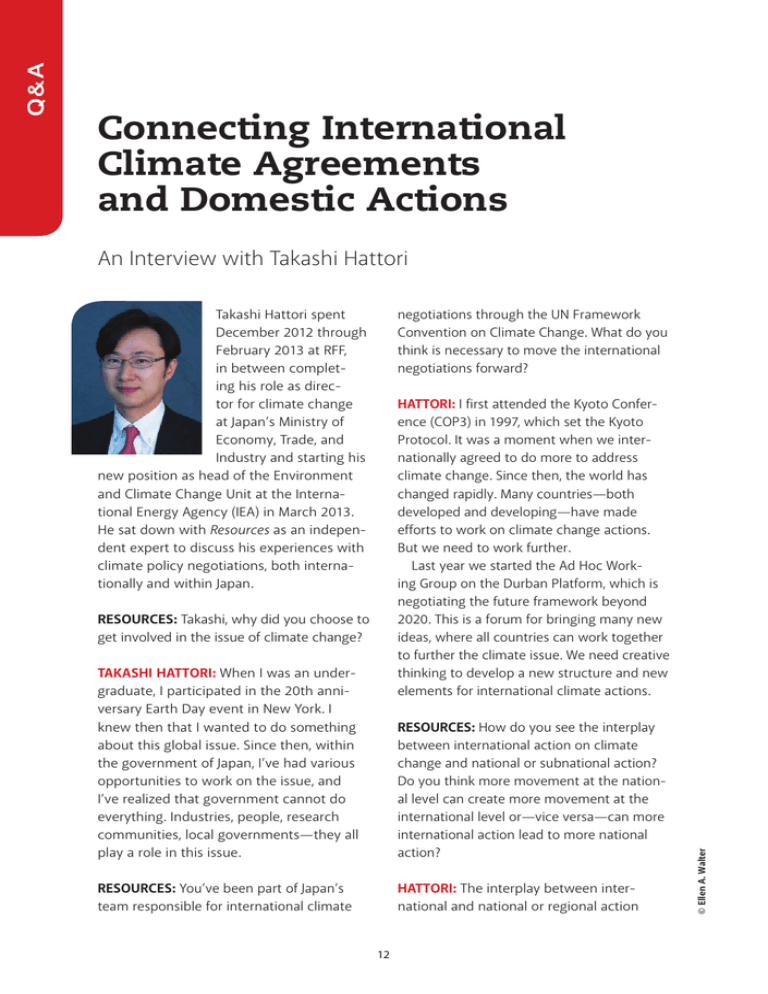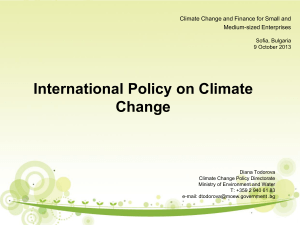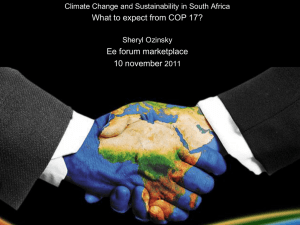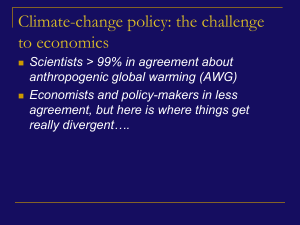Connecting International Climate Agreements and Domestic Actions An Interview with Takashi Hattori
advertisement

An Interview with Takashi Hattori negotiations through the UN Framework Convention on Climate Change. What do you think is necessary to move the international negotiations forward? Takashi Hattori spent December 2012 through February 2013 at RFF, in between completing his role as director for climate change at Japan’s Ministry of Economy, Trade, and Industry and starting his new position as head of the Environment and Climate Change Unit at the International Energy Agency (IEA) in March 2013. He sat down with Resources as an independent expert to discuss his experiences with climate policy negotiations, both internationally and within Japan. HATTORI: I first attended the Kyoto Conference (COP3) in 1997, which set the Kyoto Protocol. It was a moment when we internationally agreed to do more to address climate change. Since then, the world has changed rapidly. Many countries—both developed and developing—have made efforts to work on climate change actions. But we need to work further. Last year we started the Ad Hoc Working Group on the Durban Platform, which is negotiating the future framework beyond 2020. This is a forum for bringing many new ideas, where all countries can work together to further the climate issue. We need creative thinking to develop a new structure and new elements for international climate actions. RESOURCES: Takashi, why did you choose to get involved in the issue of climate change? TAKASHI HATTORI: When I was an undergraduate, I participated in the 20th anniversary Earth Day event in New York. I knew then that I wanted to do something about this global issue. Since then, within the government of Japan, I’ve had various opportunities to work on the issue, and I’ve realized that government cannot do everything. Industries, people, research communities, local governments—they all play a role in this issue. RESOURCES: How do you see the interplay between international action on climate change and national or subnational action? Do you think more movement at the national level can create more movement at the international level or—vice versa—can more international action lead to more national action? RESOURCES: You’ve been part of Japan’s team responsible for international climate HATTORI: The interplay between international and national or regional action 12 © Ellen A. Walter Q& A Connecting International Climate Agreements and Domestic Actions HATTORI: In Japan in 1973, we faced an energy crisis. Since then we’ve put a lot of efforts into energy efficiency. When we first encountered the issue of global climate change, we realized we had to change. We thought we should work on this problem both domestically and internationally. That’s why we held the Kyoto Conference and tried to lead actions on climate change. Recently we suffered the Great East Japan Earthquake on March 11, 2011. We lost the lives of many people. We lost nuclear power. We lost supply of electricity. And we now are in a new situation, taking a different approach to meet the goal of energy and climate change. Before the earthquake, about 30 percent of Japan’s electricity was generated by nuclear power. Right after the earthquake, we lost four plants, but then following inspections, all the nuclear plants were shut RESOURCES: How is Japan handling its own climate policy at the moment? 13 Q& A on climate change is a quite important question. In my experience, it’s best to see actions on both sides. We want to have international agreements, but in order to agree, each player needs to be comfortable with the outcome—they need to have domestic consent. In this sense, to agree on the outcome of international negotiations, we need to see domestic actions or some trends domestically toward that international agreement. There are many domestic climate policies in the United States and other countries. I think these are elements for future international agreements. And if we can reach international agreement, this perhaps enhances domestic actions. So it’s a circular process. We need both. Q& A RESOURCES: Despite the fact that Japan did not sign up to be a part of the second commitment period for the Kyoto Protocol, do you think the treaty is still the right way to move forward in reducing emissions? down. Now we are trying to review what happened, and only two plants are currently operational. Because of the loss of nuclear power, Japan increased its imports of natural gas to cover the energy shortage. But at the same time, the Japanese people and Japanese industries made efforts to reduce energy consumption. For example, they tried to limit energy use at peak times—in the hottest days of summer and in the coldest days of winter—to match supply and demand. It was an enormous effort by the Japanese people. So although carbon dioxide (CO2) emissions increased, hopefully we can still meet the target of the Kyoto Protocol. HATTORI: When we agreed on the Kyoto Protocol, it covered 59 percent of the world’s CO2 emissions. Today only about 15 percent are covered by the Kyoto Protocol because of the economic growth in developing countries. We need wider participation in working to reduce CO2 emissions, not just by developed countries, but also by developing countries. So the Kyoto Protocol is not the solution, or at least it can only serve as a partial solution. In order to bring others into international negotiations or an international agreement, perhaps we should pursue another way. In the long run, we will work on extending the international agreement beyond 2020, but while we work toward this, we should also pursue domestic actions and other international actions related to climate change. For example, in Japan we continue to work on energy efficiency, renewable policies, and other energyrelated policies. We set a target for the introduction of new renewable energy and recently introduced a feed-in tariff scheme for solar, wind, geothermal, hydro, and biomass. This is a challenge for Japan because we’ve had to rebuild our energy policy and our climate change approach. I think domestic actions are key for moving international negotiations forward. There are many new initiatives throughout the world, in the United States, in Europe, and in developing countries, such as China and India, and in Brazil. Those domestic actions will be the foundation for future international regimes. RESOURCES: Is the private sector in Japan developing technologies that will help with this transition to a low-carbon future? HATTORI: Japanese industries are quite keen to work on the climate change problem. For example, they have taken voluntary actions in the 1990s and continue to work on this issue. In terms of technology, Japanese industries are trying to develop environmentally friendly, cutting-edge, low-carbon technologies to deal with climate change. This also may help other countries if those technologies are implemented there as well. Specifically, Japan is using the Bilateral Offset Credit Mechanism to try to promote low-carbon facilities and projects in developing countries. This is where developed and developing countries work together to create new projects that generate a credit or offset that will serve both countries. In 2011 we started working together with developing countries, such as Mongolia, Vietnam, Indonesia, Thailand, Cambodia, Kenya, Ethiopia, and so on. 14






